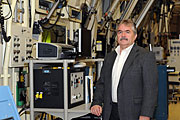- Number 357 |
- February 27, 2012
Reaching out to the nuclear industry

Doug Toomer.
Working with industry is not new for DOE's Idaho National Laboratory, but a new agreement enables the lab to support industry in a way no other national laboratory can. And Doug Toomer is just the guy for this new job.
The 35-year INL veteran has a passion for seeing the national lab become the world leader in nuclear fuel research and post-irradiation examination (PIE), and he has the knowledge, understanding and tenacity to help get the job done.
As manager of Industry Programs for INL's Nuclear Science and Technology Nuclear Fuels and Materials Division, Toomer works with the nuclear industry so it can take advantage of INL's vast capabilities to resolve issues and help prepare for tomorrow. His is a new position at INL, created after the state of Idaho and the DOE signed an agreement on Jan. 6, 2011, to streamline the process for INL to receive and store research quantities of used nuclear fuel from commercial nuclear power plants.
"I am working to take advantage of what the agreement provides INL, and I'm focusing on what INL needs to do to be the government's and industry's laboratory of choice for performing nuclear fuel research and post-irradiation examinations," Toomer says. "This single action was a major game changer in enabling INL to really support the commercial nuclear industry."
It's now Toomer's job to provide the strategic business leadership, direction and integration necessary to support that objective. He helps develop and grow INL's business by collaborating with entities involved in the commercial nuclear power industry such as the Electric Power Research Institute (EPRI), the U.S. Nuclear Regulatory Commission, fuel suppliers and utilities. Establishing and maintaining these relationships helps him understand their fuels and materials development, PIE, and characterization needs. It also helps him determine how INL can meet those needs, where gaps are and how to bridge them.
"Before you can help someone, you have to understand what they need, not what you think they need," he says. "Therefore, I will first work to truly understand what industry’s needs are; then I'll work to match our capabilities with their needs and develop ways to satisfy those needs."
Toomer says that's part of INL's role as the nation's lead laboratory for nuclear energy.
"To me, that means we need to fully understand the nuclear industry and how to help it continue deploying nuclear energy as a safe and reliable energy source for the nation," he says. "This means helping build confidence in nuclear energy; helping industry deploy new technologies; helping resolve current issues; applying lessons learned to future fuel, material and reactor designs; and helping bridge the gap from current reactors to next-generation reactors."
To assure fuel safety and performance, and to make improvements where possible, utilities, fuel suppliers (e.g., AREVA, Westinghouse, GNF) and industry organizations such as EPRI are continuously doing research and performing examinations of irradiated fuels and materials. Prior to the January 2011 agreement, the U.S. had limited capabilities to perform PIE, which often forced the American nuclear industry to go to other countries for the examinations.
But with the agreement, INL now has the opportunity to enable industry to use the lab's PIE capabilities and to establish premier capabilities within the U.S. that will support industry's current and future needs. This not only keeps the work from leaving the country, but also ensures that the United States has the capabilities for its own needs and does not become reliant on foreign resources.
"To be successful, we need industry to have confidence in us and see that we are of value to them," Toomer says. "It is important that industry views INL as a national asset that is critical to them, especially during tough budget times."
Toomer has been with INL and its predecessors for more than 35 years, primarily at what is now called the Idaho Nuclear Technology and Engineering Center. He also has worked and developed trusting relationships with nearly all the other national laboratories, the state of Idaho and many entities within the commercial nuclear industry. He has experience in spent nuclear fuel handling, storage and reprocessing, nuclear material management, facility operations and management, and project management.
"I'm not the scientist," he says, "I'm the guy who works to get things done."Submitted by DOE's Idaho National Laboratory
